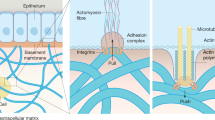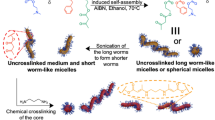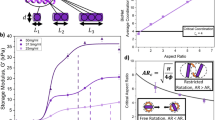Abstract
The viscoelasticity of the crosslinked semiflexible polymer networks—such as the internal cytoskeleton and the extracellular matrix—that provide shape and mechanical resistance against deformation is assumed to dominate tissue mechanics. However, the mechanical responses of soft tissues and semiflexible polymer gels differ in many respects. Tissues stiffen in compression but not in extension1,2,3,4,5, whereas semiflexible polymer networks soften in compression and stiffen in extension6,7. In shear deformation, semiflexible polymer gels stiffen with increasing strain, but tissues do not1,2,3,4,5,6,7,8. Here we use multiple experimental systems and a theoretical model to show that a combination of nonlinear polymer network elasticity and particle (cell) inclusions is essential to mimic tissue mechanics that cannot be reproduced by either biopolymer networks or colloidal particle systems alone. Tissue rheology emerges from an interplay between strain-stiffening polymer networks and volume-conserving cells within them. Polymer networks that soften in compression but stiffen in extension can be converted to materials that stiffen in compression but not in extension by including within the network either cells or inert particles to restrict the relaxation modes of the fibrous networks that surround them. Particle inclusions also suppress stiffening in shear deformation; when the particle volume fraction is low, they have little effect on the elasticity of the polymer networks. However, as the particles become more closely packed, the material switches from compression softening to compression stiffening. The emergence of an elastic response in these composite materials has implications for how tissue stiffness is altered in disease and can lead to cellular dysfunction9,10,11. Additionally, the findings could be used in the design of biomaterials with physiologically relevant mechanical properties.
This is a preview of subscription content, access via your institution
Access options
Access Nature and 54 other Nature Portfolio journals
Get Nature+, our best-value online-access subscription
$29.99 / 30 days
cancel any time
Subscribe to this journal
Receive 51 print issues and online access
$199.00 per year
only $3.90 per issue
Buy this article
- Purchase on Springer Link
- Instant access to full article PDF
Prices may be subject to local taxes which are calculated during checkout




Similar content being viewed by others
Data availability
The data that support the findings of this study are available from the corresponding authors upon reasonable request.
Code availability
The computational code developed in this work is included as Supplementary Code. The source code is covered under the GNU general public license, version 2.0 (GPL-2.0).
References
Mihai, L. A., Chin, L., Janmey, P. A. & Goriely, A. A comparison of hyperelastic constitutive models applicable to brain and fat tissues. J. R. Soc. Interface 12, 20150486 (2015).
Perepelyuk, M. et al. Normal and fibrotic rat livers demonstrate shear strain softening and compression stiffening: a model for soft tissue mechanics. PLoS ONE 11, e0146588 (2016).
Pogoda, K. et al. Compression stiffening of brain and its effect on mechanosensing by glioma cells. New J. Phys. 16, 075002 (2014).
Mihai, L. A., Budday, S., Holzapfel, G. A., Kuhl, E. & Goriely, A. A family of hyperelastic models for human brain tissue. J. Mech. Phys. Solids 106, 60–79 (2017).
Budday, S. et al. Mechanical characterization of human brain tissue. Acta Biomater. 48, 319–340 (2017).
Vahabi, M. et al. Elasticity of fibrous networks under uniaxial prestress. Soft Matter 12, 5050–5060 (2016).
van Oosten, A. S. et al. Uncoupling shear and uniaxial elastic moduli of semiflexible biopolymer networks: compression-softening and stretch-stiffening. Sci. Rep. 6, 19270 (2016).
Shah, J. V. & Janmey, P. A. Strain hardening of fibrin gels and plasma clots. Rheol. Acta 36, 262–268 (1997).
Boucher, Y., Baxter, L. T. & Jain, R. K. Interstitial pressure gradients in tissue-isolated and subcutaneous tumors: implications for therapy. Cancer Res. 50, 4478–4484 (1990).
Wyss, H. M. et al. Biophysical properties of normal and diseased renal glomeruli. Am. J. Physiol. Cell Physiol. 300, C397–C405 (2011).
Millonig, G. et al. Liver stiffness is directly influenced by central venous pressure. J. Hepatol. 52, 206–210 (2010).
Park, J. A. et al. Unjamming and cell shape in the asthmatic airway epithelium. Nat. Mater. 14, 1040–1048 (2015).
Angelini, T. E. et al. Glass-like dynamics of collective cell migration. Proc. Natl Acad. Sci. USA 108, 4714–4719 (2011).
Bi, D., Yang, X., Marchetti, M. C. & Manning, M. L. Motility-driven glass and jamming transitions in biological tissues. Phys. Rev. X 6, 021011 (2016).
Schötz, E.-M., Lanio, M., Talbot, J. A. & Manning, M. L. Glassy dynamics in three-dimensional embryonic tissues. J. R. Soc. Interface 10, 20130726 (2013).
Bernal, J. & Mason, J. Packing of spheres: coordination of randomly packed spheres. Nature 188, 910–911 (1960).
Wang, H., Abhilash, A., Chen, C. S., Wells, R. G. & Shenoy, V. B. Long-range force transmission in fibrous matrices enabled by tension-driven alignment of fibers. Biophys. J. 107, 2592–2603 (2014).
Freed, A. D. & Doehring, T. C. Elastic model for crimped collagen fibrils. J. Biomech. Eng. 127, 587–593 (2005).
Berryman, J. G. Random close packing of hard spheres and disks. Phys. Rev. A 27, 1053–1061 (1983).
Scott, G. & Kilgour, D. The density of random close packing of spheres. J. Phys. D 2, 863–866 (1969).
Acknowledgements
We acknowledge R. Wells and M. Perepelyuk for collection of rat blood, S. Diamond and R. Li for surplus blood products and D. Iwamoto for reading the manuscript. This work was supported by NIH R01GM09697, NIH U54-CA193417, EB017753 and NSF-DMR-1120901 (to P.A.J., L.C., A.E.P., K.P., K.C. and A.S.G.v.O.), by the NSF Center for Engineering Mechanobiology (CMMI-154857) through grants NSF MRSEC/DMR-1720530 R01CA232256 and U01CA202177 (X.C. and V.B.S.), by a Fulbright Science and Technology Award (A.S.G.v.O.) and by Prins Bernhard Cultuurfonds-Kuitse Fonds (A.S.G.v.O.). K.P. acknowledges partial support from the National Science Center, Poland under grant number UMO2017/26/D/ST4/00997 and from the Polish-American Fulbright Commission.
Reviewer information
Nature thanks Jasna Brujic, Ellen Kuhl and the other, anonymous, reviewer(s) for their contribution to the peer review of this work.
Author information
Authors and Affiliations
Contributions
A.S.G.v.O. and P.A.J. designed the experiments. A.S.G.v.O. performed the experiments that gave the data presented in Figs. 1b–g (except the adipose tissue data), 2b, d, 3a, c, f and Supplementary Figs. 2–9, 12–16, 18–20. L.C. performed the experiments that gave the results shown in Figs. 1b, c (adipose tissue data), 2a, g and Supplementary Figs. 1, 7–9, 11. K.P. obtained the data in Fig. 2f, h and Supplementary Figs. 10, 11. P.A.J., K.C. and A.E.P. provided the results in Figs. 2e, 3e, f and Supplementary Figs. 10, 11, 14, 17. V.B.S. and X.C. designed the computational model. X.C. generated the computational data. All authors contributed to the manuscript preparation.
Corresponding authors
Ethics declarations
Competing interests
The authors declare no competing interests.
Additional information
Publisher’s note: Springer Nature remains neutral with regard to jurisdictional claims in published maps and institutional affiliations.
Supplementary information
Supplementary Information
This file contains Supplementary Methods and Supplementary Figures.
Supplementary Code
Computational code used in this study.
Rights and permissions
About this article
Cite this article
van Oosten, A.S.G., Chen, X., Chin, L. et al. Emergence of tissue-like mechanics from fibrous networks confined by close-packed cells. Nature 573, 96–101 (2019). https://doi.org/10.1038/s41586-019-1516-5
Received:
Accepted:
Published:
Issue Date:
DOI: https://doi.org/10.1038/s41586-019-1516-5
This article is cited by
-
Elasticity-controlled jamming criticality in soft composite solids
Nature Communications (2024)
-
Cell–extracellular matrix mechanotransduction in 3D
Nature Reviews Molecular Cell Biology (2023)
-
Strain-rate-dependent material properties of human lung parenchymal tissue using inverse finite element approach
Biomechanics and Modeling in Mechanobiology (2023)
-
The importance of polyurethane/carbon nanotubes composites fabrication method to mimic mechanical behavior of different types of soft tissues
Polymer Bulletin (2023)
-
Tensile and Compressive Mechanical Behaviour of Human Blood Clot Analogues
Annals of Biomedical Engineering (2023)
Comments
By submitting a comment you agree to abide by our Terms and Community Guidelines. If you find something abusive or that does not comply with our terms or guidelines please flag it as inappropriate.



